Every marketing strategy has a primary goal.
Your primary goal might be…
- To grow your email list.
- To generate trial starts.
- To increase sales by 20%.
But someone rarely goes straight from discovering your business to becoming a customer.
And if you only focus on the primary goal, you’re missing out on a ton of opportunities. To achieve your primary goal (the macro conversion), you need to focus on the micro-conversions that move your audience through your funnel.
But what micro-conversions matter? And how do you measure them?
Read on to uncover the answers.
%(tableofcontents)
What Are Micro-Conversions?
Simply, a micro-conversion is a step on the path through your funnel and toward your macro goals.
For example: If you’re a software business and your macro (or primary) goal is to generate new customers, a micro-conversion could be defined as any step a target customer can take that moves them closer to that macro goal.
So, let’s say I run an online business and want to learn how to measure my sales better… I search Google for “eCommerce dashboards” and in the search results, Sumo ranks highly. If I click the link to Sumo’s post, that’s a micro-conversion for Sumo.

The Two Types of Micro-Conversions
Jen Cardello of Nielsen Norman Group splits micro-conversions into two groups: [*]
-
Process Milestones are conversions that represent linear movement toward a primary macro conversion. Monitoring these will help you define the steps where UX improvements are most needed.
-
Secondary Actions are not the primary goals of the site, but they are desirable actions that are indicators of potential future macro conversions.
Why You Should Track Micro-Conversions
Someone will rarely become a customer the first time they visit your website, and that’s exactly why micro-conversions are so important.
If you understand the steps people take to move through your funnel, you can optimize every step of the journey to ensure a higher conversion rate for your macro / primary goals.
For example, UGG sends back-in-stock emails to potential customers who tried to buy out of stock products on its site. Every time one of these emails is opened, it’s a micro-conversion. So if UGG can optimize open and clickthrough rates for these messages, it can increase macro-conversions (sales).

And at Sumo, SEO is a key strategy. Every click to a Sumo blog post from a search engine is a micro-conversion and brings people into the top of Sumo’s funnel. By knowing how much traffic Sumo generates from search engines and growing that figure month-on-month, Sumo can build better awareness of its brand and product.
Here’s a snapshot of Sumo’s organic blog traffic over a 12-month period. Individually each of these micro-conversions is a small win, but you can see how these micro-conversions add up to create a big impact (1.3m+ visits):

If you don’t identify and measure micro-conversions you are missing out on HUGE opportunities to grow your business. Even small improvements will compound and result in big payoffs.
8 Micro-Conversion Examples (And How To Measure Them)
1. Email Capture
Sumo knows just how important it is to grow an email list, and capturing email leads is a huge win for any business.
With micro-conversions, capturing an email is one of the most important. It takes a lot to get someone to opt-in to communications from a brand — especially via email — so someone sharing their email address with your business is a HUGE sign that they are interested in what you’re offering.
Want to see the power of capturing email leads?
Look no further than Appsumo. Its email marketing strategy has helped it to capture over 1.8million email addresses and it now sends 4 emails per week to around 60,000 recipients and makes $30,000 in revenue per email.

That’s impressive right? But driving all of this revenue wouldn’t be possible if it wasn’t for the focus on every micro-conversion along the way.
How To Measure Email Capture
There are tons of email marketing metrics you can look at. But for measuring this micro-conversion, I’d recommend looking at your list growth and the number of new emails you capture each week or month.
Here’s an example of OkDork monthly list growth on SendFox:
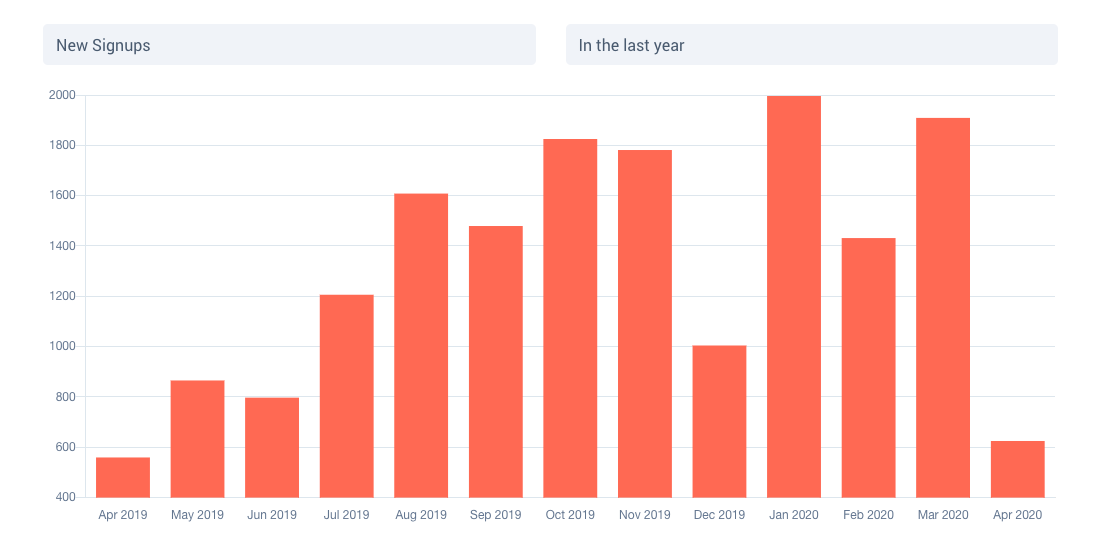
2. Social Media Follows
Social media follower numbers can be a bit of a vanity metric. But each new follower is someone showing an intent to learn more about your business, and a sign that they like what you’re doing.
Not only is each new follower a potential new lead for your business, it’s a win for social proof.
Having 1k, 10k or even 100k Instagram followers shows people that your brand is popular, and that in itself can play a major role in convincing others to follow your brand or check out your website.
How To Measure Social Media Follows
The simplest way to measure social media followers and new follower growth is to keep all the data in a spreadsheet.

Most social platforms show follower data publicly and you can simply make a note of follower counts each week or month to measure growth.
3. Viewing A Product Or Sales Page
Once you’ve got a potential (or returning customer) to your website (a micro-conversion in itself) getting them past the homepage and into a product or sales page is an important step.
Visiting a product or sales page is a show of intent. It tells you what that person is looking for.
For example, someone visiting an eCommerce store like Allbirds and looking at one of their ‘Mens’ Wool Runner’ shoes can provide a lot of data:
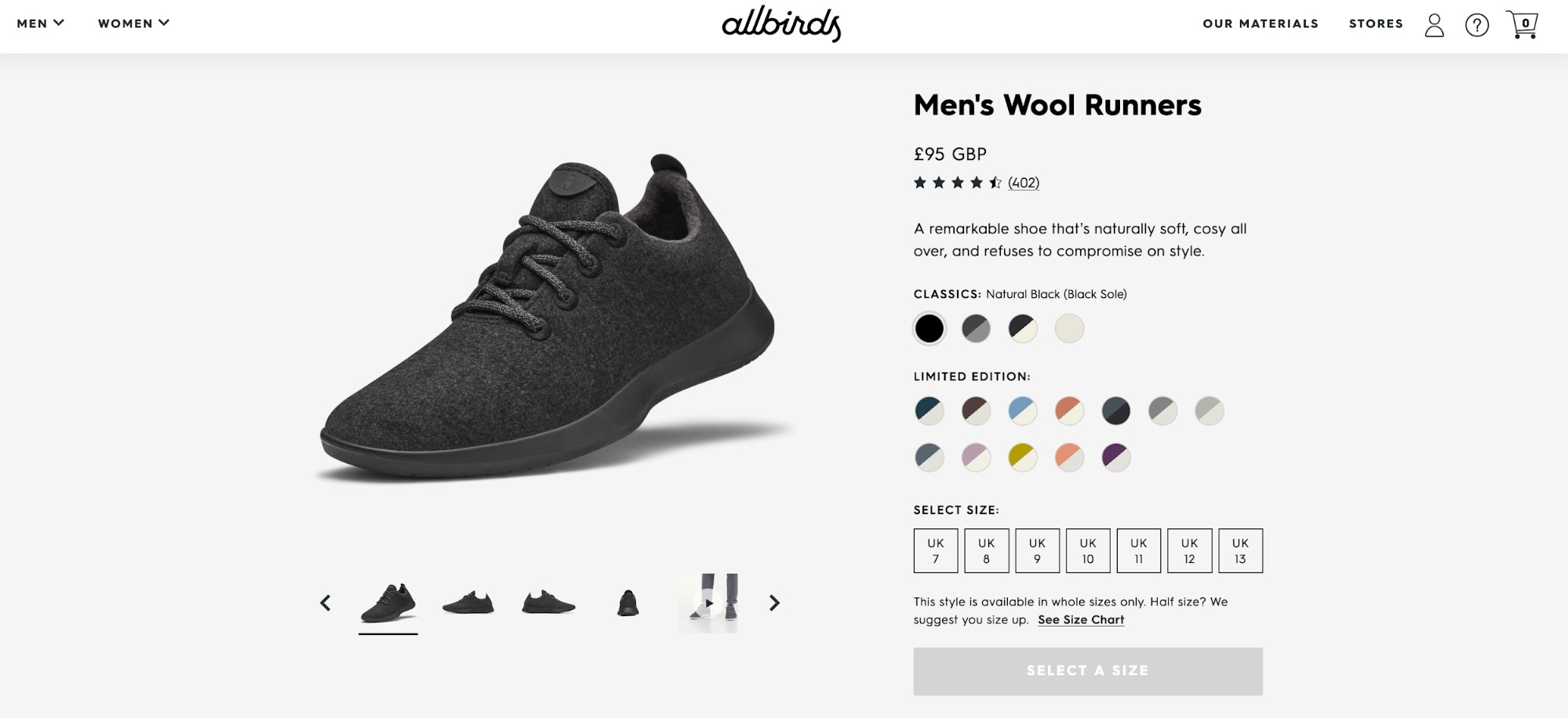
- The style of shoe they are looking for
- They want a men's shoe
- The color they like (if they click)
- The size they need (if they click)
All of this data can be super valuable even if they don’t complete the purchase there and then.
You can use this data for retargeting campaigns to bring shoppers back to your site or by simply looking at the number of people who visit a sales or product page you can see which pages are most popular and have the best conversion rates.
How To Measure Product Or Sales Page Views
This can be tracked in Google Analytics. Head to Analytics, select ‘Behavior’, ‘Overview’ and then click ‘View full report’ in the bottom right of the screen:
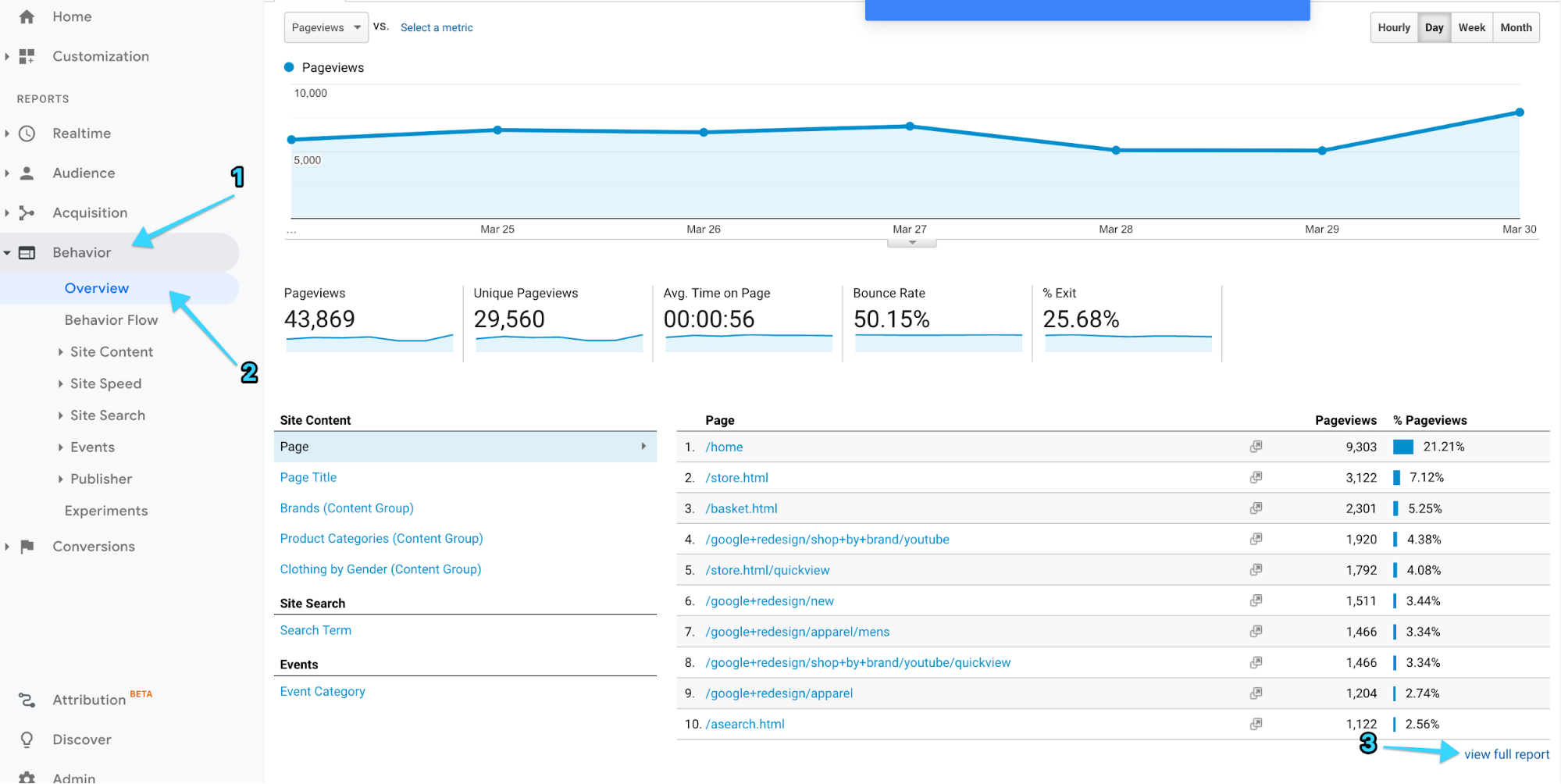
On the next screen, you’ll be able to locate any page on your website. Enter the name of your product as it’s displayed in your product page URL in the search bar and you’ll then see all pages that match that query:

Click the link under the ‘Page’ heading and you’ll then be able to see all the relevant data for that specific product page on your website. This will tell you have many views, unique views, time on page and more.
4. Opening Your Emails
Capturing a new email address is a big win (we covered this in point #1 above). But what’s just as important is having engaged subscribers on your list.
If someone joins your email list and doesn’t ever open one of your emails, they aren’t going to help your business much. In fact, sending emails to thousands of people who never open them might be an expense for your business.
But subscribers that open your emails and click links (both micro-conversions) are invaluable. So it’s important to keep track of how many of your subscribers are actually engaging with the content you’re sending them.
How To Measure Email Opens
Most email marketing software will report on email opens (and clicks) for each email you send. Focus on these numbers and experiment with subject lines and CTAs to see how you can improve your numbers.
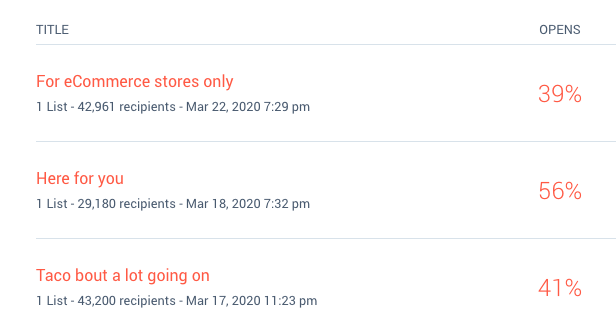
5. Cart Abandonment
In a perfect world, every time a product was added to a cart in an online store the shopper would complete checkout.
Cart abandonment is a big problem for all stores. In fact, it’s estimated that ecommerce businesses lose more than $4.6 trillion through abandoned carts each year. [*]
But having an item on your site added to a shopper’s cart is a hugely valuable micro-conversion. Once an item is in the cart, you’re just one step away from making a sale.
And even if someone abandons their cart or leaves your website before they complete checkout, you can still claw back that revenue through offers and well timed cart abandonment emails.

How To Measure Cart Abandonment
Ecommerce tools like Shopify will store data about cart abandonment rates and successful checkouts. (Here’s how to find it on Shopify.) With this data you can begin to strategize ways to reduce abandonment and increase conversions once a shopper has left your site without checking out.
6. Downloading A Content Upgrade
One of the best ways to generate leads from your website is to offer a content upgrade of free download (eBook, templates, report, etc).

When you capture a lead through a content upgrade it’s a show of intent that they are interested in your business, and if the content is super high-quality, this micro-conversion can help to move each lead closer to making a purchase.
How To Measure Content Upgrade Downloads
Each content upgrade you offer could add leads to a seperate email list or trigger a separate download email. To measure these micro-conversions you should look at the growth of your content upgrade lists and the number of people who opened and clicked emails (this will tell you how many actually checked out your upgrade).
7. CTA Clicks
Basically every action we take online is the result of some form of call to action (CTA).
CTAs will power almost every type of micro-conversion. From “Follow” buttons on Instagram, to “Download Now” buttons on content upgrades and “Buy Now” buttons on online stores.
When someone clicks a CTA, it’s a micro-conversion. By measuring this micro-conversion, you can test out a range of messages, colors, offers and more to ensure your CTAs are irresistible to your visitors.
How To Measure CTA Clicks
To measure CTA clicks, you can use a tool like Crazy Egg or Hotjar to create heatmaps to show where people are clicking on your page.
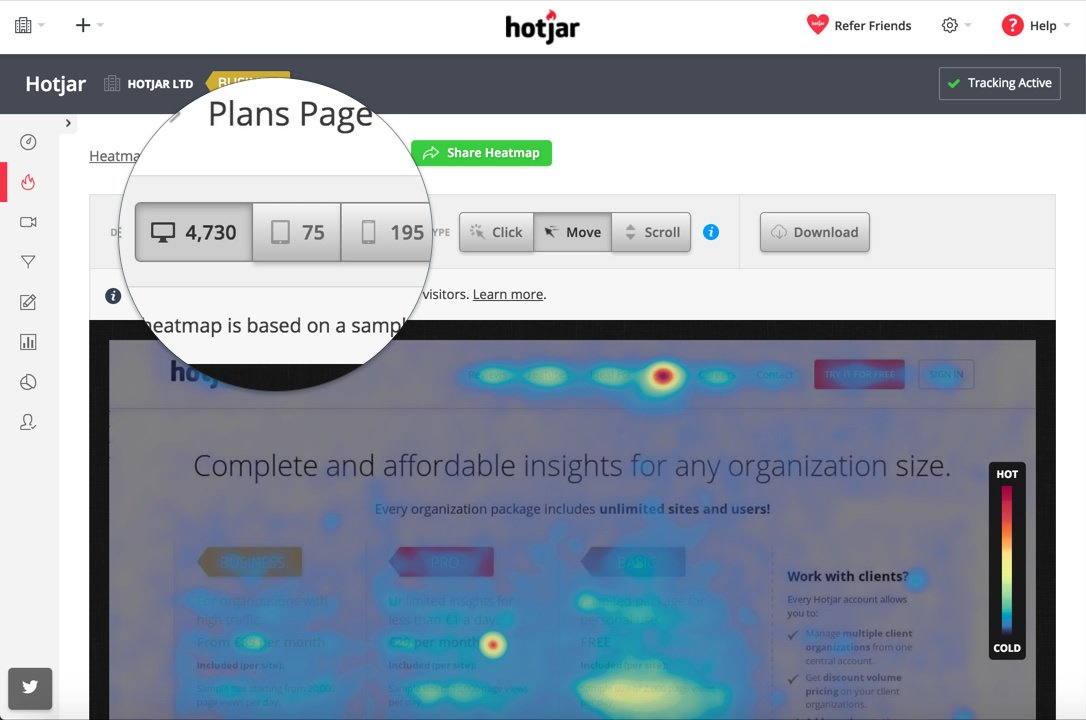
You could also use a URL shortening tool like Bit.ly to create a link and see the exact number of clicks it has generated.

8. Visiting Your Website From Search Results
SEO is a great way to drive more traffic to your website. And every visit generated from search is a micro-conversion.
Every search that results in a visit to your website can also boost the chances of other micro-conversions happening like CTA clicks and email capture.
And even if every visit doesn’t result in someone moving further into your funnel, it’s a way to build awareness.
How To Measure Visits From Search
You can measure visits from search via Google Analytics. Open up Analytics and click ‘Acquisition’, ‘Overview’ and then ‘Organic Search’:

If you want to dig even deeper into your search data, you can set up Google Search Console to find which keywords your business is ranking for and how much traffic each is driving.
Which Micro-Conversions Will Your Track?
Remember: Every customer will go on a journey before they ultimately buy your product or service.
Along that journey there will be many micro-conversions, each providing your business with an opportunity to connect with potential customers and move them closer to your primary goal.
The eight examples I’ve shared today are great starting points for measuring your micro-conversions. But there are plenty more micro-conversions you could measure.
Think about your ideal customer journey and which micro-conversions are most important along the way. These are where you should focus first.
Add A Comment
VIEW THE COMMENTS